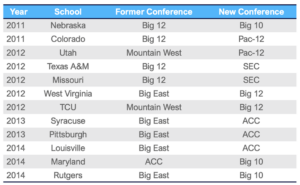The Notre Dame college football team is independent. What would happen if it joined a conference? Let’s look at the data behind a decision like this and the possible economic outcomes.
The landscape of college football is rapidly changing. We saw this play out between 2011 and 2014 when 12 major universities switched conferences (see below). Over the seven years that followed, there were numerous rumors of impending moves but little activity.
In July 2021, Texas and Oklahoma announced their moves from the Big 12 conference to the SEC conference starting in 2025. Then in June 2022, USC and UCLA announced their departures from the Pac-12 conference to the Big Ten conference starting in 2024 (see our previous blog, “USC, UCLA Big Ten Playbook” here). This shift left the ACC, Big 12, and Pac-12 conferences vulnerable to further expansion of the SEC and Big Ten 16-team “super conferences.” This has prompted a new wave of conference realignment talks, and many view Notre Dame as a prime target for any conference looking to add to its ranks.

More from UB: How to make a stronger case for the ROI of a college degree
Why Are Athletics Important to Colleges and Universities?
Athletic departments generate revenue for academic institutions primarily in three forms: ticket sales, alumni/booster donations and NCAA/conference distribution. Athletic departments also spend considerable amounts on coaches’ salaries and benefits, scholarships, travel and facilities.
Athletics impact the brand of a university. For example, 75% of schools that make it into the Final Four of the NCAA men’s basketball tournament see a larger-than-normal surge in applications received the following admission season, according to data from the National Center for Education Statistics.
Colleges and universities should consider the academic side of their sports teams. Adding or removing a team could substantially impact an institution’s tuition revenue, financial aid, and instructional expenses. It behooves most colleges and universities to analyze the financial contribution of their student-athletes by sports teams. Further research could break down the academic programs the student-athletes are majoring in. Doing so could project the impact of roster adjustments to sports teams on academic programs in terms of enrollment and economics.
Academic Program Economics of Sports Teams
If Notre Dame were to move its other sports teams from the ACC to the Big Ten or SEC, it would gain exposure to new sports not currently sponsored by the ACC. One example is women’s field hockey in the Big Ten. A roster for such a team typically includes over 20 student-athletes. What if Notre Dame were to launch a new women’s field hockey team? In addition to the athletic department costs (e.g., coaches, travel), the university should consider the impact on Education and other academic program areas that field hockey players are likely to major in. The academic economics of field hockey is very favorable, as shown in this disguised example of a team in this sport.

Combining sports economic data with academic program evaluation systems empowers both athletic directors and provosts to analyze the data and foster collaborative decision-making. This leads to better outcomes for both athletics and academic departments. It also allows schools to find new ways to bolster the enrollment of specific academic programs by launching new cost-efficient sports.
Notre Dame’s Next Move
When USC and UCLA announced their move from the Pac-12 to the Big Ten, Notre Dame’s knee-jerk reaction could have been to leave football independence behind and join a conference. However, the university remained patient and stood its ground. It appears poised to continue to do so until external circumstances leave them with no choice but to join a conference. The key factors in this decision will include tradition, media rights revenue, scheduling, travel, and access to the college football playoff. Only time will tell if this day ever comes.
This type of analysis can be applied at other schools considering a conference change or just looking to add new sports based on market demand and program economics. These decisions also affect the enrollment of academic programs as certain sports attract students who major in specific programs. At Gray Associates, we are developing a dashboard and datasets to help schools understand the results of these decisions. Click here if you would like to learn more.








